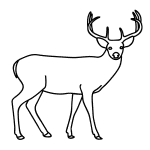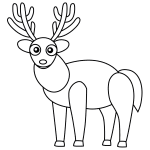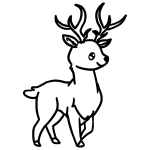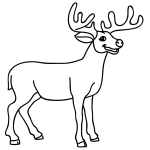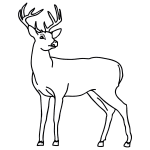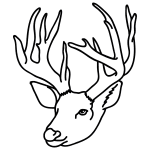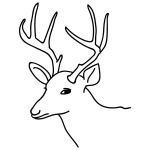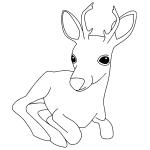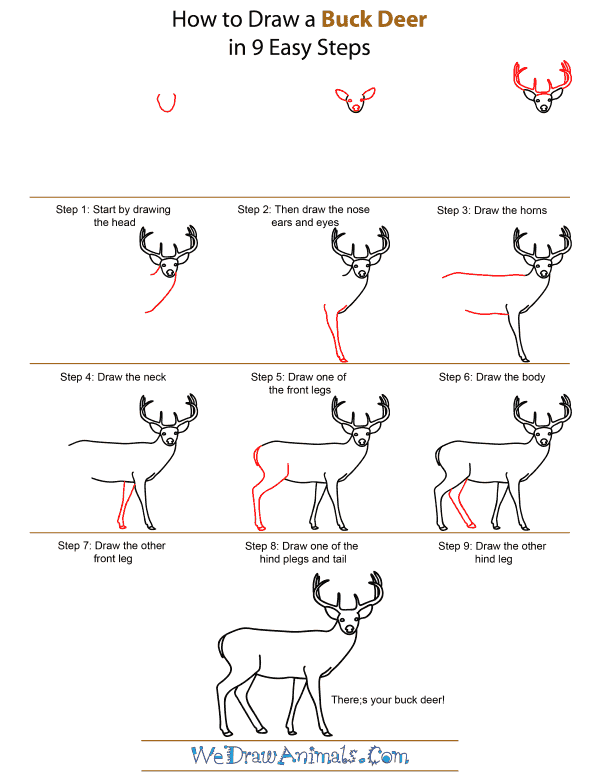In this quick tutorial you'll learn how to draw a Buck Deer in 9 easy steps - great for kids and novice artists.
The images above represent how your finished drawing is going to look and the steps involved.
Below are the individual steps - you can click on each one for a High Resolution printable PDF version.
At the bottom you can read some interesting facts about the Buck Deer.
Make sure you also check out any of the hundreds of drawing tutorials grouped by category.
How to Draw a Buck Deer - Step-by-Step Tutorial
Step 1: Drawing a Buck Deer (or boy deer) can look complicated, but its easy if you take your time. Start by making the head, with a deep curve, a bit like a vase or pottery.
Step 2: Now draw in two ovals on either side of the head, pointing up slightly to make the ears. Now put in two circles just beside the ears to make the eyes. Now add a funny, bumpy shape that is like an oval with two round bumps near the top on either side to make the nose, just at the bottom of the face.
Step 3: Now draw the antlers. Did you know, that only boy Deer have antlers? Skip this step if you want to draw a girl deer, or a 'Doe.'
Step 4: Below the left ear, draw a down and left slanting line that curves near the end to make part of the neck. Then draw a line that starts on the right side of the deer's face, and goes down before curving down and to the left to make the chest.
Step 5: For the first leg and hoof, make a line that slants down and to the left that starts just above the line at the bottom of the chest. It should then curve down, curving a bit to the right at the very bottom. Then on the left side, drw a line that curves very slightly at the top, before slanting down with a slight wobble, to imply powerful muscles in the leg. It should slant towards the front at the bottom, and draw a line just above the very bottom of the leg you've made to create the hoof.
Step 6: To draw the back and the belly, start by making a flat line that starts from the back of the neck, and goes left. Near the end there should be a small hump to imply a hip. The belly should start with a line just behind the leg, and going back. It should be short to leave room for other legs, and curve up slightly.
Step 7: Let's draw another leg behind that one. It should be two lines that are slightly apart, and come almost together at the very bottom, curving a bit towards the right as well. Then draw a small line just above the bottom of the leg, to make a hoof.
Step 8: The back leg is going to be different from the front, it needs to be bigger so the antelope can leap and run! Draw it with two lines. The first will start above its belly, and curve down, and turn towards the front very slightly! The second line should start very near the antelope's rear, and curve inward, before following the front line down to a hoof. Make sure to add a small curve just behind the Deer's rear to make the tail.
Step 9: The last leg will be just to the right of the back leg you've drawn. It should be made of two lines, one starting at the joint between the back and leg and the belly, the other starting about halfway down the 'calf' of the back leg. The lines should slant down and to the left at first, before turning to slant down and to the right. Near the bottom there should be a line that makes the hoof.
Interesting Facts about Buck Deer
Buck deer are male deer. Unlike female deer, which are called doe, buck deer have large antlers on their head. Buck deer are native to all continents except Antarctica and Australia.
Did You Know?
- The average size of a full-grown buck deer is 7 feet long.
- The average weight of an adult buck deer ranges from 130 to 300 pounds.
- A buck deer is also called a stag. Depending on the species, they are also referred to as harts or bulls.
- Buck deer use their antlers as weapons while fighting each other.
- When deer are born, they stay with their mother for about one year. After that year, buck deer usually never see their mother again.
- Chinese water deer are the only species in which the buck deer has tusks instead of antlers.
- Male moose have the largest antlers of all buck deer.
Once a year, buck deer shed their antlers and grow them back. Their antlers usually begin to grow in late winter or early spring. Buck deer that live in tropical regions shed their antlers any time of the year. Some buck deer species that live close the equator do not shed their antlers at all.

